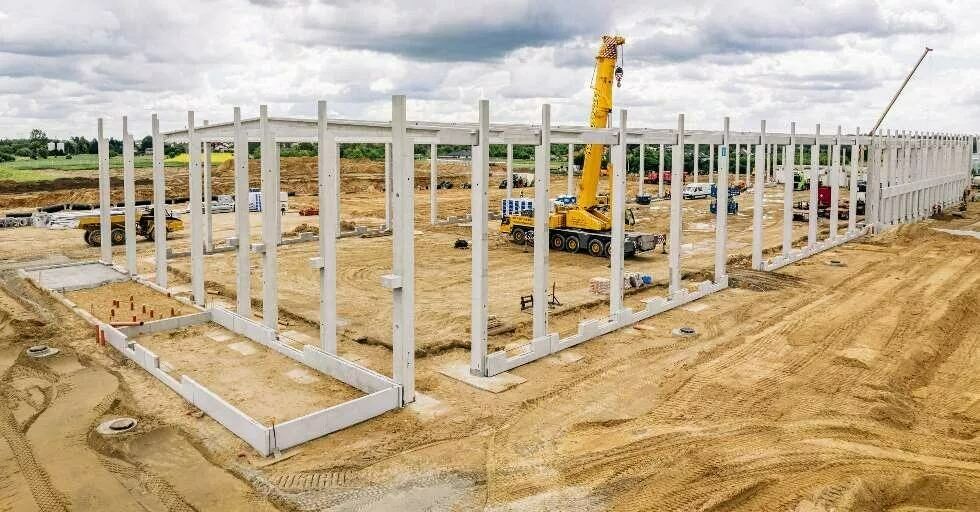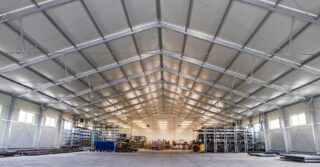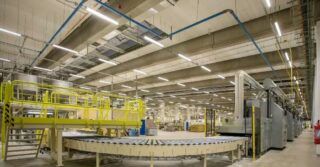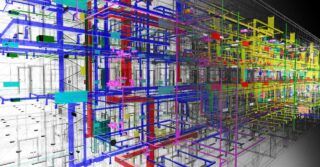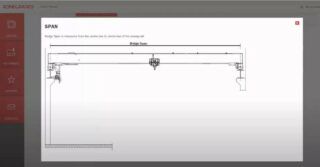The situation of industrial construction in Poland has been changing dynamically over the past three years. The years 2020 and 2021 were marked by a pandemic surge – the growth of the e-commerce sector and the uncertainty of supply from Asia meant that more and more investors decided to build warehousing and production facilities in our country.
And when it seemed that such a trend would be difficult to reverse, the situation was unexpectedly changed by the war in Ukraine. Its effects strongly shook investment moods last year. However, the situation seems to be slowly stabilising and investors in the industrial sector are considering building new facilities. How should they prepare for an interview with a potential general contractor?
Documentation is a must for construction to start
When deciding to build a production facility, the investor should expect a rather long and often complicated preparatory procedure. Since many of them are aware of that, may of them, already at this stage, decide to have the future general contractor involved in the formal procedure. – Many investors opt for such cooperation, already at the preparatory stage, and, from experience, I can say that this is a very good decision. As a general contractor, we are knowledgeable and experienced not only in the construction work, but also in procedural matters, easily coping with the complexities of administration and construction law. I would like to point out that the development of complete design documentation, i.e. both the drawing and descriptive part of the project, which is prepared by the designer, as well as the necessary documents to be obtained during the design process, is a lengthy process requiring a huge time commitment. It is often longer than the time required for the very project to complete, and such a commitment is something that investors simply cannot afford – explains Beata Kwiecień, contract manager at Commercecon.
However, if you decide to handle formal matters yourself, depending on whether you already own a plot of land or whether you only intend to purchase it, you should analyse the Local Development Plan, possibly apply for development conditions in order to verify potential restrictions on the development of the plot and check whether the provisions contained in these documents correspond to the requirements of the planned project. Subsequently, you should analyse the issue of access to the plot and the local conditions in terms of access to utilities (water, electricity, gas, district heating, sanitary and storm water drainage). You can, for example, use the portal www.geoportal.gov.pl or apply for connection conditions straight away.
At the same time, it is a desirable step to carry out a geotechnical study of the ground in order to rule out foundation problems. One of the final elements of the pre-design stage is to obtain a map for design purposes, which should be requested from a surveyor – this will form the basis for the development of a site plan for the future project. Without these documents, we will not be able to proceed to the next stage of the project, which is the design process itself.
Overall, both the purchase of a plot of land and the acquisition of the necessary documents to start work on a project require a great deal of commitment on your part and a series of decisions whose consequences will affect you in the future
Plant area – how much space will you need?
Once the investor is sure that the plot of land purchased suits the nature of the planned project, the next stage of preparatory work can begin. What is it? Identification of the area to be used for future activities. This is one of the most important pieces of information for the general contractor, as it indicates the scale of the implementation and thus determines the level of commitment of the execution team. What other questions will the investor have to answer? – During the first initial discussion on the project completion, we will certainly want to know the characteristics of the production process. The process itself usually already determines the shape of the facility, but also its division into different zones, such as the production hall, the warehouse for components and finished products, laboratories, as well as the technical and staff areas or, finally, the office space that usually accompanies such facilities. It is also necessary to determine what part of the external area should be developed to serve the planned development (car parks, access roads, storage yards, internal roads, external infrastructure facilities – pumping stations, fire water tanks, waste storage areas, bicycle sheds, etc.) – explains Beata Kwiecień.
Not also that the investor’s production process is often so complex that the process design is required in order to properly design the internal systems. As the Commercecon expert points out, it is already worth considering the future and expansion of the company at this stage of the work, and therefore – if the land allows it – to make provisions for the potential future plant extension. This is because all of these activities affect the architectural design and construction of the building, which is being developed at the moment.
All of the above information will allow you to optimally design the building and plan its location on the plot. And the more effort that is put into the design, the fewer problems the investor will have to face during the construction and use of the building.
Production and material storage characteristics
The aforementioned characteristics of the process are also crucial in determining the types of systems required. And it is not just about basic heating, electrical sockets and lighting, plumbing, HVAC, but also specialised systems required for the production process, such as compressed air, air or dust extraction, or sprinkler systems. As Beata Kwiecień explains, to face current trends aimed at reducing the carbon footprint and emissions, it is possible to recover some of the process heat which can then be used to heat the building or domestic hot water. This is a very beneficial solution that is not only sustainable, but also economic, giving you tangible savings. – It will both, reduce the day-to-day running cost of the facility resulting from the energy demands, but also allow the company to pursue the first pillar of the increasingly fashionable ESG strategy, which is environmental care – she adds.
Extremely important, from the point of view of the construction of the building and the timing of the construction work, is information about the machinery or process line involved. This is about both, the dimensioning (additional loads on the foundations and other structural elements to which they will be attached) and the planned date of installation. This is because in the history of Commercecon, there was a situation where – in order to transport elements of the machinery park to the finished hall – a section of the roof sheathing had to be dismantled.
It is also worth considering the storage of components for production as well as finished products – what type of material they will be packaged in and how they will be stored. As Beata Kwiecień explains, the information provided may affect the determination of the fire load of the hall, and this in turn may entail the need for additional, often costly, fire protection, such as a sprinkler system.

Material handling in the industrial hall and external logistics
Most medium-sized and large production halls require the means of material handling. The most commonly used form is various types of forklift trucks and other vehicles operating on in-plant roads, and these in turn may have different power sources (lithium-ion batteries, acid batteries, LPG). Why do we pay attention to this? – I know from experience that asking this question at such an early stage can take the investor by surprise. Seemingly irrelevant, this issue is quite significant from our point of view. In practice, it may mean that we need to design additional solutions, such as charging stations for battery-powered trucks or shelters for gas cylinders, or the installation of hydrogen vapour detection or exhaust fumes, if we have to deal with such a drive – the contract manager at Commercecon explains.
Every production facility also requires external transport planning – after all, component deliveries will be necessary, as well as the loading and export of finished products. At the construction planning stage, it is therefore necessary to determine the need for loading docks (their number and type), as well as to estimate the volume of traffic (the strength of the gates) and the type of vehicles that will dominate logistics operations. This will affect the landscaping around the building and allow it to be optimally connected by a junction to the public road.
The topics presented are of course not exhaustive of all the issues that a general contractor will certainly want to discuss. However, they will give you an idea of how many decisions you have to make already at the preliminary planning stage of the future project and the selection of the contractor.


